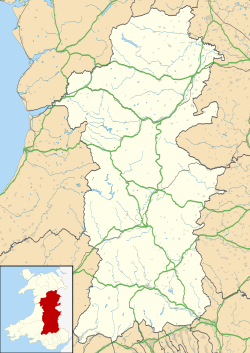St Llwchaiarn's church, Llanllwchaiarn
| St Llwchaiarn’s church, Llanllwchaiarn | |
|---|---|

Llanllwchaiarn. Church from SE
|
|
| Coordinates: 52°31′24″N 3°17′30″W / 52.5232°N 3.2916°W | |
| Location | Newtown with Llanllwchaiarn, Powys |
| Country | Wales |
| Denomination | Church in Wales |
| History | |
| Founder(s) | St Llwchaiarn |
| Dedication | St Llwchaiarn |
| Consecrated | Probably 7th century AD |
| Events | Rebuilt 1816 |
| Architecture | |
| Functional status | Active |
| Heritage designation | Grade II |
| Designated | 18 July 1949 |
| Architectural type | Church |
| Style | Georgian with Victorian interior |
| Construction cost | £1200 |
| Administration | |
| Parish | Llanllwchaiarn |
| Archdeaconry | Montgomery |
| Diocese | St Asaph |
St Llwchaiarn’s church, Llanllwchaiarn was the parish church of Llanllwchaiarn, now within the community of Newtown with Llanllwchaiarn and lies within the historic county of Montgomeryshire in Powys. The church occupies a position on rising ground overlooking the river Severn and is to the north east of Newtown. The present church was rebuilt in 1816. In 2011 the medieval carved screen, originally from St Mary’s church in Newtown, was re-positioned in Llanllwchaiarn church
The Church is dedicated to the 6th-century Saint Llwchaiarn or Lluwchaiarn, who was also the patron saint of the adjacent parish if Llanmerewig and of two parishes in Ceredigion. The 16th-century local Welsh poet, Siôn Ceri describes the various feats and miracles attributed to the saint which include slaying a dragon and causing a hind to leap into a pool of water, but there is very little certain evidence about the life of the saint.
In recent times the churchyard has been extended, but the original churchyard, is a raised area that is almost circular, and contains many historic yew trees. The combination of a church within an almost circular churchyard and an early dedication would suggest that it was founded in the 6th or 7th centuries. The church is recorded in the Norwich Taxation of 1254 as 'Ecc'a de Llanlocharen' with a value of £1 6s 8d. In 1263 part of it was appropriated to the Cistercian nunnery at Llanllugan, and in 1291 the combined value was £4 6s 8d.
In the 1790s Thomas Pennant commissioned John Ingleby to produce a series of watercolours for a revised version of his Tour in Wales. The watercolours are now in the collections of the National Library of Wales.
In 1795 Pennant commissioned two watercolurs from John Ingelby of Llanllwchaiarn Church. These two illustrations of the parish church, before it was re-built in 1815 appear to be the only ones in existence. The old church was an example of a church with an internally supported bell tower. The first view shows the church from the south and looking across the river Severn and the second shows the church from the North.
The present church was built on the old site in 1815 at a cost of £1,200. The re-built church was a simple Georgian brick church with a square tower was built and in 1864 a chancel and vestry were added1. Recently, the fine carved Medieval rood screen from the old church at Newtown, that had been moved to St David’s Church, was moved again to Llanllwchaiarn.
...
Wikipedia

